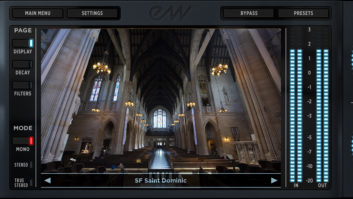My first encounter with the EMT-156 dates back to 1982, when I was wrapping up a project with Bay Area band The Mutants (as produced by the late Snakefinger) at the Fantasy Studio complex in Berkeley, Calif. Restoring two of these beasts, along with several other vintage compressor/limiters in the past three years, has proved both intriguing and challenging.
A simple maintenance or “repair” job on a piece of 30-something gear can quickly evolve into a restoration project, and component age and previous repair history are just two (of many) considerations. Once hidden by analog tape hiss, the noise of vintage devices may be excessive by digital’s standards, leading older gear to fall off of the ledge of acceptability. There are several disciplines applied to any vintage restoration: achieving (and accepting) original performance and making improvements that minimize obvious flaws without sacrificing the “coolness” factors.
For example, repairs and upgrades to the power supply and attention to power and ground distribution can reduce power-related noise without significantly altering desirable sonic characteristics. I’m not squeamish about this from a restoration perspective, but it is a sensitive subject for those attempting a faithful reproduction. In the case of Universal Audio’s 1176 reissue, the new version retains the original shunt-style Zener clamp for voltage regulation. Modern products typically use a TO-220 (case-style) three-terminal regulator, boasting better regulation, lower noise and greater efficiency. Many a vintage 1176 has darkened its printed circuit board under the resistor that feeds the Zener. Shunt regulation ain’t about pretty: It’s brute-force-effective and hot-hot-hot!
MUTE ANT
Originally intended as an FM broadcast processor, the EMT-156 is itself a mutant, being neither optical, FET nor VCA, but instead using Pulse-Width Modulation (PWM) to control the amount of audio passing through a diode bridge! While not the cleanest solution, it is quite agile and surprisingly well-behaved when working properly. As unusual as its topology may seem, Dave Hill at Crane Song saw the strengths of PWM, substituting high-speed video FETs for the diodes in his STC-8 and Trakker designs.
The EMT-156 is at least 30 years old: The date code from its single Pulse-Width Modulator IC is 1972; the rest of the unit uses discrete transistors. (Who says time travel isn’t possible?) Even though the EMT-156 is over-engineered to ensure a long, trouble-free life, it was also built with consideration for the service technician, as are the company’s Reverb amplifiers. The card-cage chassis has slots for application-specific subassemblies — power supply, input amp, output amp, compressor-limiter, expander, Pulse-Width Modulator, etc. — which explains why the unit eats up the real-estate equivalent of its weight. The power and output transformers are massive.
As shown in Fig. 1, perhaps the most endearing and educational feature of the EMT-156 is the Transfer Function graph on the front panel: an X-Y plot with color-coded dots corresponding to knob caps, a pictorial explanation of the function and range of controls. It’s something you expect in a user’s manual or laminated cheat sheet, but this is back in the day when rack real estate was cheap!
The first EMT-156 arrived for repair in 1999 (from David Glasser of Airshow Mastering) suffering from an intermittent Pulse-Width Modulator, poor signal-to-noise performance and between 2% and 4% distortion — yikes! The manual specifies distortion between 0.6% and 1.0%, depending on settings; S/N is 70 dB on its best day. The second unit arrived DOA (along with an Eventide Omnipressor) from Dave Russell, manager/engineer of Walter Becker’s Hyperbolic Studio in Maui. Its power supply was traced backward from its output terminals, which revealed the transformer was suspect — dead as if the secondary was shorted but the fuse was still good. A very service-oriented product, the EMT-156 supply can be run outside of its card cage.
SHIP SHAPE
Temporarily connecting an external power transformer to the diode bridge confirmed that resurrection was possible. While removing the old transformer, I noticed that most of its legs had sheared off: a process that began whenever the unit had been shipped — a round trip from Maui to New York City and then to the Twin Cities. The importance of adequate protection for shipping can not be discounted. In lieu of the original packaging, use fat bubble-wrap around the device in question and put that box in a larger box with several inches of peanuts all around. Too often, gear arrives with insufficient packaging. Some are lucky, others are not.
THE SKINNY FACTS
Each EMT-156 has unique problems in addition to its “genetic” faults. Both units needed to be recapped. Over time, modules get swapped or technicians focus on repairs more than performance. Especially with any stereo unit, it’s important to have identical parts in each channel for phase integrity. I used Panasonic FC aluminum electrolytic capacitors to replace all of the electrolytics.
The Pulse-Width Modulator is a high-frequency (HF) square wave oscillator modulated by a DC control voltage (CV), representing dynamic changes in the audio signal. Probing inside the unit with a scope revealed HF noise radiating into everything, but suppressed at the output transformer by a serious series resistor-capacitor (RC) shunt as termination. High frequencies tend to travel on the outside of the wire — solid in this case — and bundled, a phenomenon known as “the skin effect.” On the first unit, I spent some time rerouting cables and redistributing the ground with some improvement. On the second unit, the focus was on filtering the power as it entered each module and revamping the power supply.
The EMT-156 power supply is unconventional by modern standards. The unit derives bipolar 10 volts by dividing a single regulated supply in half. This means that the “ground” or power common is virtual, explaining the vulnerability to accidental shorts when probing for clues (and slipping). The solution for the first unit was to upgrade and heat-sink one critical transistor to improve fault tolerance.
Once the transformer was removed, repaired and re-installed (on the second unit), a quick check of the system revealed basic functionality, as well as all of the noises documented with the first unit. The Pulse-Width Modulator was a major concern when considering the supply options. As the only (and ancient) chip in the system — in a circuit that is very dependent on power regulation and calibration — any drifting affects gain, gain reduction and distortion.
THE GROUND FLOOR
Noise sources can be identified with the help of spectral analysis. Sure, you can jack up the gain, but who wants to listen to noise for extended periods, risking monitors and hearing with one fell glitch? Instead, a handy little NTI Minilyzer zoomed in on the noise. To the left in Fig. 2a are three spikes, the obvious family of power-related noise components: 60Hz, 120Hz and 240Hz hum (in the U.S. and other 60Hz countries). Rising slightly to the right is amplifier hiss. Figure 2b reflects the same device after surgery — quite an improvement, so here’s the story.
PCB traces from the output of the original power supply were cut to allow connection from an external DC regulator. I then built up a little prototype board with LM317 and LM337 (positive and negative adjustable regulators, respectively). This board now lives in the power supply area that is externally fed by a regulated, bipolar 15-volt supply. Because the EMT-156 runs on bipolar 10 volts, protection from the outside world was an important consideration in the event that any of its components are sensitive to excessive voltage. I also wanted some guarantee of cleanliness, no matter what external supply was used.
Reducing the hum components by 18 dB was rewarding. Similar changes occur when experimenting with ground distribution; keep in mind that it’s just as easy to make things worse as it is better. The beauty, of course, is real-time observation via Spectrum Analyzer. Power supply source-impedance can also affect high-frequency noise, as I learned while experimenting with “bypassing” the supply vs. local cleanup at each of the cards. A series resistor and parallel cap were not as effective as a series inductor and the cap. Understand that all of the PWM noise was beyond audible range, while hiss overlapped three audible octaves.
While attempting to calibrate the unit, it became obvious that many of the pots and switches were scratchy. Trim pots were replaced, rotary pots disassembled and cleaned, and switches were lubricated and exercised. On the switches, I used Caig Deoxit D100L in the pinpoint oiler bottle rather than make a mess with a spray. On the pots, once the oxidation was removed from the silver, a Caig paste was used to lubricate and protect.
Both units eventually came together and made some cool, and funky sounds. The EMT-156 is very much the unconventional box from stem to stern, so using it is equally twisted. Gain-reduction metering is the “zero-center”-type: To the left is compression, and to the right is limiting. The unit operates completely in reverse of most compressors, with 18 dB of attenuation until the compression gain control is rotated clockwise. This moves the meter to the left, increasing gain until the threshold bumps into the signal.
The compressor, limiter and expander are independent circuits that become interactive when any or all are engaged. The compressor has both ratio (1.5:1 to 4:1) as well as rotation (fine-tuning threshold from -1.5 dB to -6 dB). The expander rotation control operates in a similar way, plus it has two front-panel ratio switches. Attack for all modes is internally set, while release is available on the front panel. The limiter can also be viewed in a special meter mode called (dB) ATT/sec. Because peaks are faster than most meters can respond to, a capacitor is added to elongate the impulse, allowing more accurate setting of the peak-threshold control.
ANALOG CHIC
We think of the 1950s as the golden era of the vacuum tube. Like the gradual evolution of digital (and our acceptance of the same), the transistor was only approaching the knee of its maturity in the early ’70s: a time when ICs were still in their infancy. Sure, API and Neve were doing some cool stuff, but there has been considerable progress since then, especially with power supplies and components. Then as now, large consoles have remote power supplies; the distance pretty much eliminates the transformer as noise source. This was not a luxury for most vintage outboard gear, although now, toroidal (round) transformers can easily be positioned to minimize radiation. Welcome to the ground floor of noise awareness!
Eddie thanks all of his customers for being patient (while he writes term papers about their gear). Visit him atwww.tangible-technology.com.
INSIDER TRADING
Inside nearly all dynamics processors is a control voltage (CV) that, when probed with an oscilloscope, sheds a much more revealing (green) light on the effects of the front-panel controls than looking at metering. While this kind of insider information is usually only available to geeks, the EMT-156 provides access to this via a rear-panel DIN connector, allowing the user to optimize the processor for maximum efficiency.
For example, some dynamics processors do their best work at the “knee,” while others continue doing respectable work while being slammed. The dbx 160 Series is an example of the former: A pair of LEDs labeled “Above” and “Below” encourage the user to find the knee’s center, a comfort zone where the unit does its most efficient work. Conversely, the UREI 1176 allows massive gain-reduction meter swings, maintaining its deserved reputation; although like any processor, combined “fast” settings of attack and release controls will narrow the window of tolerance.
I also put the equally obtuse Eventide Omnipressor on the bench. Like the EMT-156, it also has a zero-center gain-reduction meter. (See Fig. 3.) The Omnipressor is the archetype for VCA compressors. Based around a dbx discrete transistor VCA, it has every possible control you never thought of such as separate limit controls for gain and attenuation.
The key to coaxing good sounds out of Omnipressor (or any dbx compressor with this feature) is to set threshold so that the above/below LEDs are always toggling. This centers the processing at the knee where the compressors do their best work. Make small moves and the Omnipressor is more usable than I ever thought possible. But be forewarned: Twist knobs with wild abandon only after taking out insurance on your monitors!
— Eddie Ciletti







